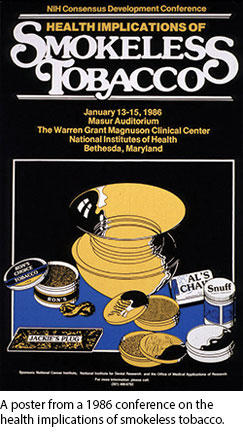Smokeless Tobacco and Oral Cancer Risk
DCEG research on the association between smokeless tobacco and cancer has made a significant impact on the regulation of snuff and other smokeless tobacco products.
This work began when investigators studying the U.S. Cancer Mortality Atlas observed a striking elevation of oral cancer rates among women in the rural south. In a case-control study conducted in North Carolina, elevated risk for cancer was associated with long-term use of snuff among nonsmokers, demonstrating a 50-fold increased risk for tissues in direct contact with tobacco. The report published in the New England Journal of Medicine stimulated congressional hearings that resulted in regulatory actions to control the advertising and labeling of smokeless tobacco and educational campaigns to reduce its use by young people.
Low-intensity Smokers are at Increased Risk of Earlier Death
Cigarette smoking is known to cause more than 20 types of cancer as well as other diseases, but the effects of low-intensity smoking (10 or fewer cigarettes per day) have not been well studied.
Maki Inoue-Choi, Ph.D., M.S., R.D., Neal Freedman, Ph.D., M.P.H., and colleagues showed that among 290,215 adults in the National Institutes of Health-AARP Diet and Health Study, current smokers who had smoked less than one cigarette per day over their lifetime had 1.64 times higher mortality risk and smokers who had smoked one to 10 cigarettes per day had 1.87 times higher mortality risk than never smokers. Risks were lower among former smokers compared to those who continued to smoke and fell with earlier age at quitting.
These results provide further evidence that there is no safe level of exposure to tobacco smoke and that even low-intensity smokers benefit from cessation.
